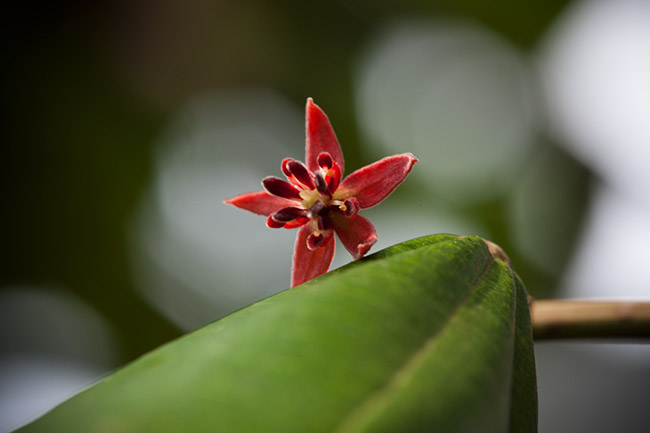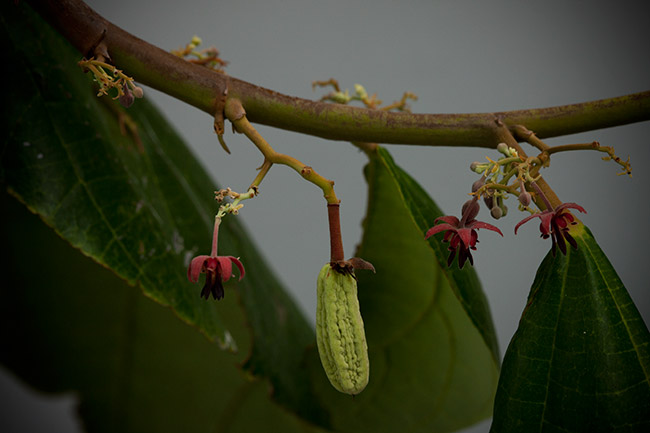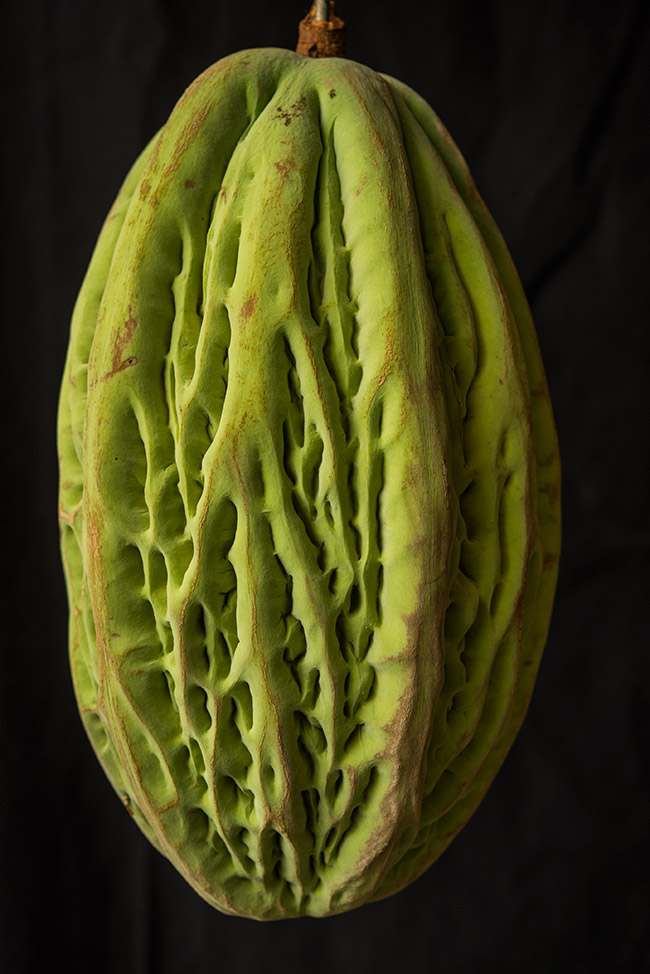Pataxte is a second species of cacao for cocoa, chocolate of the Maya and of Mesoamerica. Theobroma cacao is the more common species for chocolate today. In past centuries a third species, Theobroma angustifolium was used (wild cacao, monkey cacao). Today there are probably fewer than a hundred Theobroma angustifolium trees remaining. One by one, the few which are left are being cut down every year.
Perhaps a thousand or so Theobroma bicolor trees exist. These are also being cut down every year. Theobroma cacao is where all the millions of dollars of international cocoa and chocolate money goes into research on breeding new varieties. So there are probably "a million" Theobroma cacao trees in the Maya areas of Mexico, Guatemala, Honduras, and El Salvador (not to count the even more in Costa Rica and the rest of Mesoamerica).
Because Theobroma angustifolium is almost extinct within Guatemala and because we have noticed how many pataxte cacao trees are being chopped down, we are working at developing a project to do a tree census. As soon as funding is available we can do the actual census (literally, going out to the remote areas and counting the trees of the two endangered species, then working on projects to protect the ones remaining, and planting more to increase the count).
Pataxte flower Found at Samayac.
The Popol Vuh mentions pataxte and cacao in the same breath
Reading the Popol Vuh is probably where a lot of people see the word pataxte. I first used the Popol Vuh after Michael Coe discovered so many parallels with scenes on Maya vases (circa 1973, The Maya Scribe and his World). Prior to that Frans Blom had written on a polychrome Maya plate which clearly showed aspects of a scene in the Popol Vuh.
I made two trips to Mexico and was able to find this plate (which no one had seen since Blom photographed it in the 1950's). To make sure the plate was not looted, I encouraged the owner to donate it to INAH and it was indeed donated to a museum in Quintana Roo. Since this plate was so important it was later moved to the larger museum in Merida, Yucatan. I used the scene on this plate during my PhD research of the 1980's.
Show the Blom Plate, the back cover of my PhD dissertation
Although the plate does not show cacao or pataxte, this was the kind of iconography which kept me reading the Popol Vuh, where I kept seeing pataxte mentioned in tandem with cacao.
As a side note, since it is unlikely that much cacao or even pataxte grows at the elevation of near where the Popol Vuh manuscript was found (near Chichicastenango, El Quiche), the constant mention of pataxte and cacao suggests that the area of origin of aspects of the mythology was in an area of pataxte and cacao. The earliest representations of scenes from the Popol Vuh are from sea level area of Izapa, Tapachula, Chiapas, Mexico, the Preclassic stucco facades of El Mirador (El Peten-Calakmul border), and San Bartolo (lowland El Peten).
Jaguars and Slicer Bats (of the Popol Vuh) are present in the mountains of Alta Verapaz (and El Peten), but unlikely in the higher mountains of El Quiche. So in general, much of the Popol Vuh probably originated in the Lowlands or at least in areas with connections with Alta Verapaz. Ironically, Pataxte does not appear to be very common in El Peten; if this can be documented botanically, it will help focus the search for the origins of the Popol Vuh, chapter by chapter (since what we have today is over 1600 years of compilation from most realistically more than one source, probably about 1800-1900 years, minimum).
Cacao blooms and fruits on the trunk
Pataxte does not bloom nor fruit on the trunk
It is well known that Theobroma cacao blooms and fruits from the entire lower trunk. As soon as you have seen a few pataxte trees you quickly realize that there are no flowers on the trunk, and no fruits on the trunk. All the flowers and fruits are from upper branches.
Cacao does not fall from the trunk, you have to cut it off
Pataxte falls down when it is ripe
To harvest a cacao pod you cut it off the tree trunk. To harvest a pataxte pod there is often no way to reach it. Most pataxte is so high that even with a ladder you can't reach the pods. In order to photograph flowers we search for days, driving long distances, until we can find a tree with branches low enough that we can photograph the flowers with a close-up macro lens.
Young Pataxte fruit.
Young pataxte trees have giant leaves
Mature pataxte trees have leaves of normal size
Only recently have I found any botanical monograph or peer-reviewed journal which has thoroughly discussed the fact that the leaves of young pataxte trees (one, two, three years old) are large, very large leaves. Then when the tree is getting old enough to eventually flower and have fruits, the leaves are no longer the large ones. The leaves and branches of pataxte are discussed by Cook (1916). We will show the sequence of leaf size when funding allows us to produce a coffee table book on cacao species..
Pataxte pod, found in Alta Verapaz, July 2014.
Pataxte has been growing in Guatemala for centuries
Pataxte is actually relatively common in many places throughout Guatemala. I first really began learning about the actual physical tree over a decade ago when I noticed at Takalik Abaj how different the pataxte cacao tree was from a Theobroma cacao tree.
Once I saw how different pataxte was, I wanted to do more research. An early source of information was available in 2006, by botanist MacVean.
One listing of where to find pataxte in Guatemala is by MacVean (2006:156).
- Las regions bajas de la bocacosta Pacifica
- Alta Verapaz (with no specification, since only certain areas have Pataxte)
- Chiquimula (which I have not seen listed before by others, but is by Standley)
- Solola (which I have not seen listed before by others)
- Santa Rosa
Year after year I have kept my eyes and ears open about pataxte and have found it growing in many locations, but ironically not yet in Chiquimula, Solola, or Santa Rosa (three areas where MacVean lists for Pataxte). But we have found Pataxte growing in several areas not listed at all by MacVean: San Marcos and Izabal. Both of these two latter areas are major centers.
I would be very pleasantly surprised to find much pataxte around Chiquimula, Solola, or Santa Rosa. Chiquimula and Santa Rosa are so much drier than anywhere else that Pataxte thrives. Maybe in uses river areas to get moisture?
Here is my list:
- San Marcos, many areas around Tumbador and further in.
- Suchitepequez, widespread
- Alta Verapaz, very common in some areas
- Izabal, I estimate there were massive stands here until exterminated by cattle ranches, agro-commercial plantations (sugar, African oil palm, etc)
- Huehuetenango, near Ixcan (Standley and Steyermark 1949:422)
- Quezaltenango (Standley and Steyermark 1949:422)
There are several places in Guatemala named Pataxte
Here is Rio Pataxte, on the agro-business African palm oil plantation of NaturAceites. Actually there were so many streams flowing through this plantation it was a challenge to keep track.
This is the Aldea Pataxte, Municipio de El Estor, Izabal, Guatemala. It is also called Aldea Playa Pataxte, or Caserio Pataxte. This settlement is also called Caxlampom Pataxte.
Finca Pataxte is elsewhere listed as Panzos, Alta Verapaz. But Panzos is across the departmental border.
There is also an archaeological site of Pataxte, Izabal. The Thesis of Licenciatura of Bernard Hermes is on this archaeological site. I have not been to this site, but it would be interesting to read what has been written on Maya archaeology in this area to find out if the local nearby obsidian source is identified. Most of the modern roads through NaturAceites plantation area have landfill with a high percentage of (unworked) obsidian (so obsidian from a hill, not from an archaeological site). This plantation is on land which was originally thick with pataxte.
Rio Pataxte, San Marcos, east of the Mexico-Guatemala border
There is a little known second river called Rio Pataxte, in the steep Boca Costa foothills of the large mountains of this part of Guatemala (towards the Mexican border of Highland Chiapas). http://travelingluck.com/North+America/Guatemala/San+Marcos/_3591556_R%C3%ADo+Pataxte.html and www.deguate.com/artman/publish/geo-rios/rio-pataxte-san-marcos.shtml#.VM0cZCgQiS0
Se ha catalogado como un corto río Suroccidental de Guatemala. Se localiza en la región de los municipios de El Tumbador y Catarina, Departamento de San Marcos, Guatemala.
Su trayecto es de Este a Oeste. Atraviesa la aldea La Democracia, pasa entre las haciendas El Refugio y Margaritas, continúa su curso al Este de la aldea San Juan Meléndrez para desembocar en río Xulá.
www.deguate.com/artman/publish/geo-rios/rio-pataxte-san-marcos.shtml#.VIu07SgQiS0
This Rio Pataxte of San Marcos is not related whatsoever to Rio Pataxte in Izabal. That of Izabal is near sea level; that of San Marcos is probably over 500 meters and possibly much more. It is also worth noting that most of the Pataxte growing around Alta Verapaz is nowhere near sea level.
It would help to have a botanical study of why there is not as much Pataxte in El Peten, and at most only a little in Belize. The three major areas of Pataxte in Guatemala are: the Rio Pataxte area of Izabal; the Rio Pataxte area of San Marcos, and a significant portion of Alta Verapaz.
There is also a caserio named Pataxte in Jutiapa
It is so seasonally dry throughout Jutiapa, I find it hard to believe that Theobroma bicolor grows here. But this is a good example of a good project for a biology student, to find this caserio and ask around.
Having a plant name as a place name is no guarantee that the plant even exists at this location. The best example is El Achiote, Chiquimula, Guatemala. This is along the CA9, Carretera al Atlantico. This is a dry area and I would be very surprised if there is any achiote within 100 kilometers! Even a thousand years ago I doubt there was achiote within even 100 miles.
Summary, on where various sources feel that
Pataxte, Theobroma bicolor, grows in Guatemala
| Standley 1949 | MacVean | Nicholas list |
|---|
| Suchitepequez | Las regions bajas de la bocacosta Pacifica | Bocacosta for sure; we have found it in Suchitepequez especially |
| Alta Verapaz | Alta Verapaz, but no mention which parts yes and which areas not present whatsoever | Alta Verapaz, but by no means everywhere |
| Chiquimula | Chiquimula | - |
| - | Sololá | - |
| Santa Rosa | Santa Rosa | - |
| Huehuetenango, near Ixcan | - | I would accept what Standly suggests, but the Ixcan river is also in El Quiche side. |
| Quezaltenango | - | Possibly |
| - | - | San Marcos, very common in some areas. |
| - | - | Izabal, very common in one area near Rio Pataxte, but 90% bulldozed. |
Where I seriously doubt there would be much pataxte;
- Baja Verapaz, not impossible in some areas but unlikely overall.
- Chiquimula, maybe in river valley, but unlikely overall.
- Santa Rosa, maybe in river valley, or in recent K'ekchi' settlement, but otherwise not expected.
- Jutiapa is also rather dry, but we will try to find the caserio Pataxte to see if there are any trees there.
We will need to see whether most of the pataxte is in only throughout Suchitepéquez or whether it is also equally common in the adjacent Departamento, Retalhuleu.
Our bibliography on Pataxte
Our bibliography on Pataxte is now available.
Most recently updated July 19, 2016.
First posted February 2, 2015
As we continue our studies of all forms of cacao for making cocoa and chocolate.
















































































